
When I think about radio broadcasters keeping pace with new technology, I always see it through the programming lens.
What type of content should we be creating in order to stay competitive? And what distribution outlets should we be focusing on?

But of course, there’s the all-important sales side. And it’s another area where radio companies haven’t always kept up. That’s the view of our digital revenue strategist and AI guy, Chris Brunt. He spent years in both digital programming and sales while at the Beasley/Greater Media cluster here in Detroit. Chris has a unique view of the challenges radio is currently facing.
Recently, he attended Borrell Associates conference in Miami, and in today’s post, he takes a look at a trend in advertising that radio would do well to add to its arsenal. As we programming people have learned, our content falls flat if we can’t properly and effectively monetize it.
No one said it would be easy. – FJ
By Chris Brunt
Our industry has always been better at fretting about the monsters under the bed — whatever the latest existential threats are that will steal our audiences and ad dollars — than bragging about our successes. In 2024, sure TSL is down and GenZ-Super-P1s are rare, but radio is now the undisputed largest mass-medium in the US. No other medium reaches as many people every week than broadcast radio. Even in automobiles with Apple CarPlay, radio listenership levels are double that of streaming platforms or satellite radio. On the content side, broadcasters have mostly been adept at adjusting and evolving to downsizing and expense cutting in order to maintain audience engagement.
On the sales side, however, the broadcast radio M.O. is too similar to how it was 15 or even 20 years ago:
Prospect, CNA (Customer Needs Analysis), Pitch, Close. Rinse, Lather, Repeat. A minimum of two meetings with the client.
 This, in spite of the fact there’s been a dramatic shift in how those coveted small and medium-sized businesses – SMBs for short – are purchasing advertising. And these local businesses are radio’s bread-and-butter.
This, in spite of the fact there’s been a dramatic shift in how those coveted small and medium-sized businesses – SMBs for short – are purchasing advertising. And these local businesses are radio’s bread-and-butter.
When you think about other consumer spending, much of it falls into the self-service bucket – filling up our gas tanks (unless you’re in New Jersey), checking out at a grocery store or pharmacy, purchasing mass transit tickets, and a growing list of transactions where we’d rather do it ourselves. We’re scanning, swiping, bagging, and moving on. In the world of media advertising, it’s not much different.
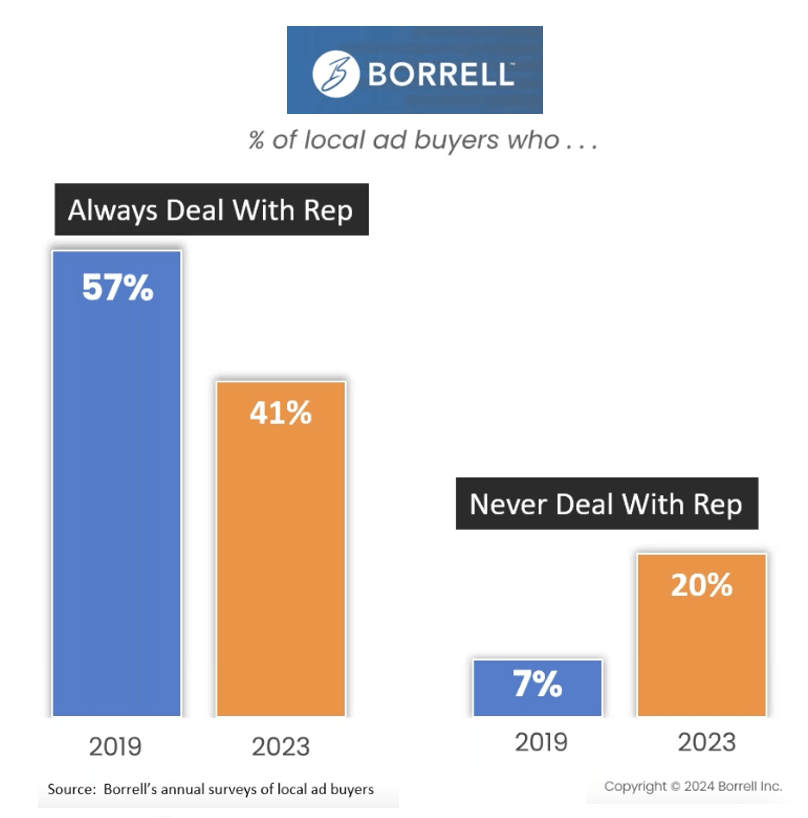
Just as listening habits changed during COVID, so have advertisers’ methods of purchasing the campaigns they run. According to local media research from Borrell Associates, only four in ten local advertisers (41%) exclusively communicate with ad reps to buy advertising, which means nearly six in ten are using some sort of self-service platform. Notably, one fifth (20%) NEVER use an ad rep.
And as Borrell’s chart clearly shows, utilizing another human to purchase ads is becoming less prevalent. Since before COVID in 2019, the percentage of personal ad rep interaction has decreased by 28%. Meantime, those who never deal with a rep has nearly tripled during this same time period.
With Google, Facebook, and other out-of-market platforms taking a majority of many markets’ local ad spend, it is imperative radio broadcasters make purchasing advertising as friction-less as possible. Whether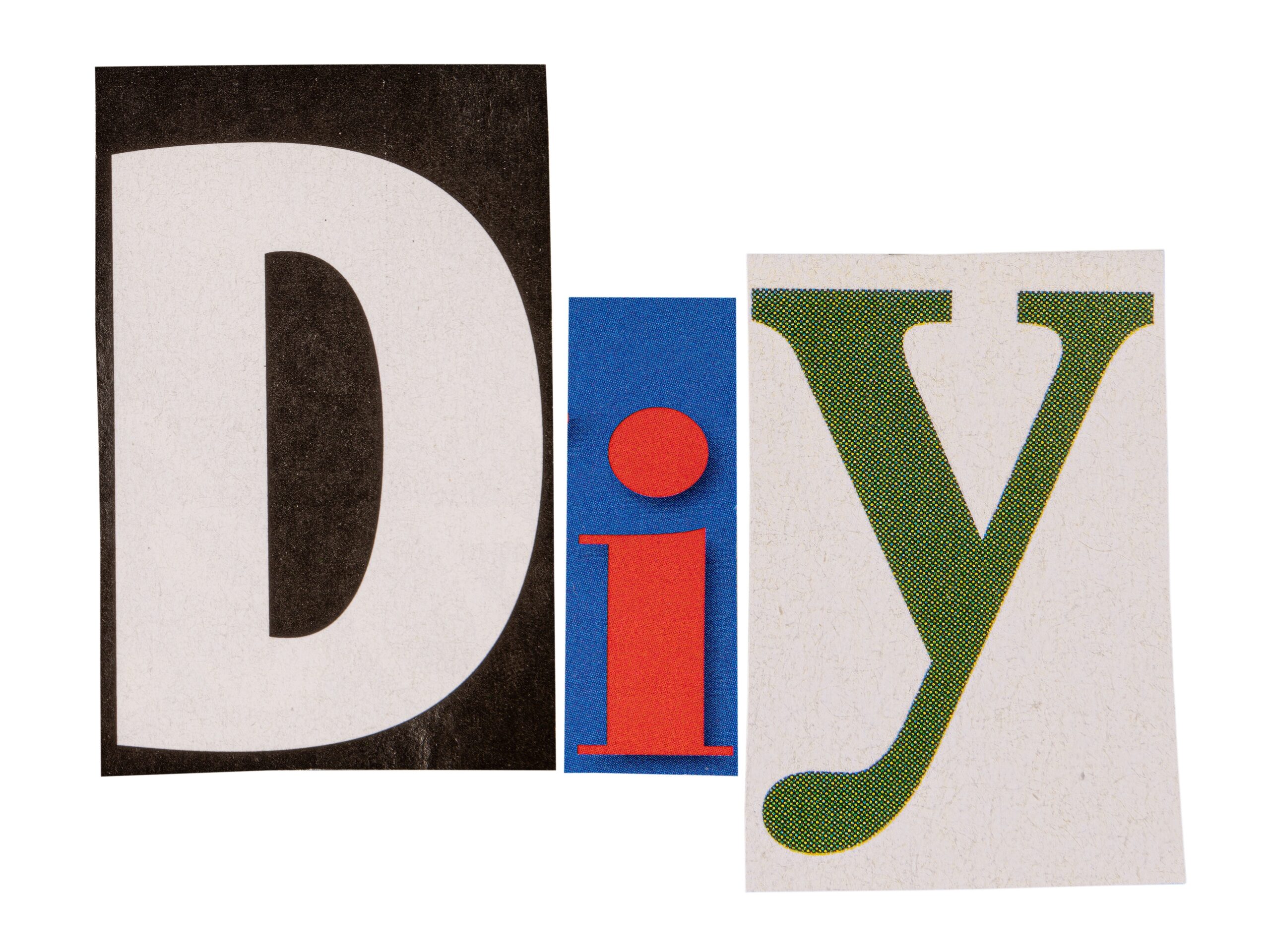 advertisers are dealing with local media outlets or trillion-dollar digital giants, they are increasingly expecting a DIY approach to media buying.
advertisers are dealing with local media outlets or trillion-dollar digital giants, they are increasingly expecting a DIY approach to media buying.
Think about it from a business owner’s perspective: You own a local roofing company and you manage everything from staffing to marketing to payroll. By the time you have a chance to look at next month’s bookings, it’s 10pm and you realize you need more visibility.
So what’s easier?
- A self-service portal from Meta or Google where the ad will be running by the morning.
OR - Filling out a form on a radio station’s website for a salesperson to call the next day (when you’re back at the office putting out fires) to set up a CNA meeting, waiting for that meeting, waiting perhaps a day or more for the proposal presentation, dealing with creative, and then waiting even more for campaign execution.
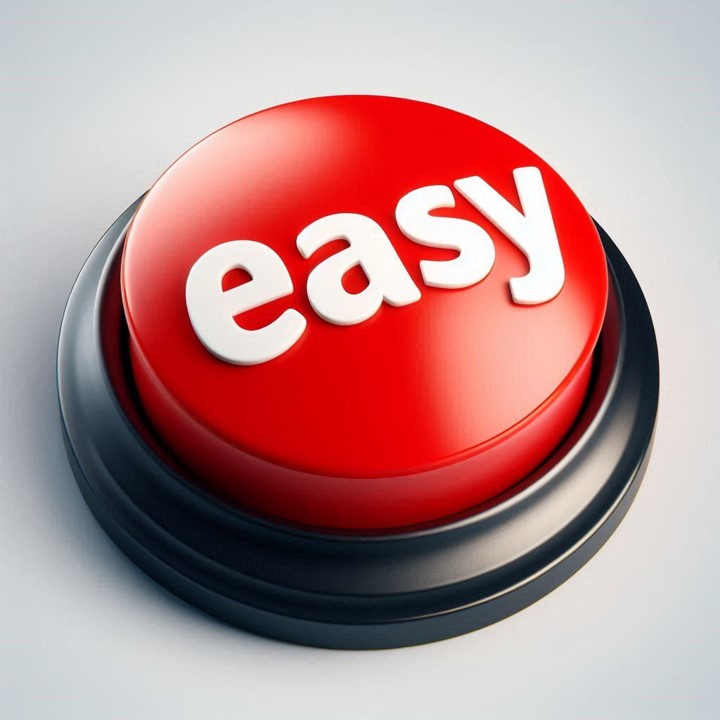 Where is radio’s “EASY” button for advertisers?
Where is radio’s “EASY” button for advertisers?
Outside of Google and Meta, other media companies are stepping up to the self-service game:
- Disney spent a good chunk of 2022-23 optimizing Hulu’s self-service portal, now allowing advertisers to set up targeted campaigns by age, zip code, and viewing affinities — including NFL fans. The only thing a business owner needs to do is to provide a video and a credit card number.
- Paramount Advertising COO Steve Ellis has made SMB advertising a priority, telling The Current, “Although those SMBs have been very active on social platforms, … we want and will build a [digital video] product that’s much more effective and easier to use.”
- Spotify’s in on self-service. If you want to market your small business on their platform, head over to http://ads.spotify.com, and provide the zips, ages, genders, and interests of the audience you want to reach. Submit the copy, and you’ll get the commercial back in two days. When the campaign goes live, you start seeing stats on your dashboard.
- Local TV giants Nexstar and Gray want those local business ad dollars too. They are planning a self-service platform for their OTT platform Premion.
To be sure, a self-service platform doesn’t mean there isn’t a role for local AEs in the sales mix. They are essential to the long-term survival and growth of the industry as marketing strategists for their stations’ biggest accounts. 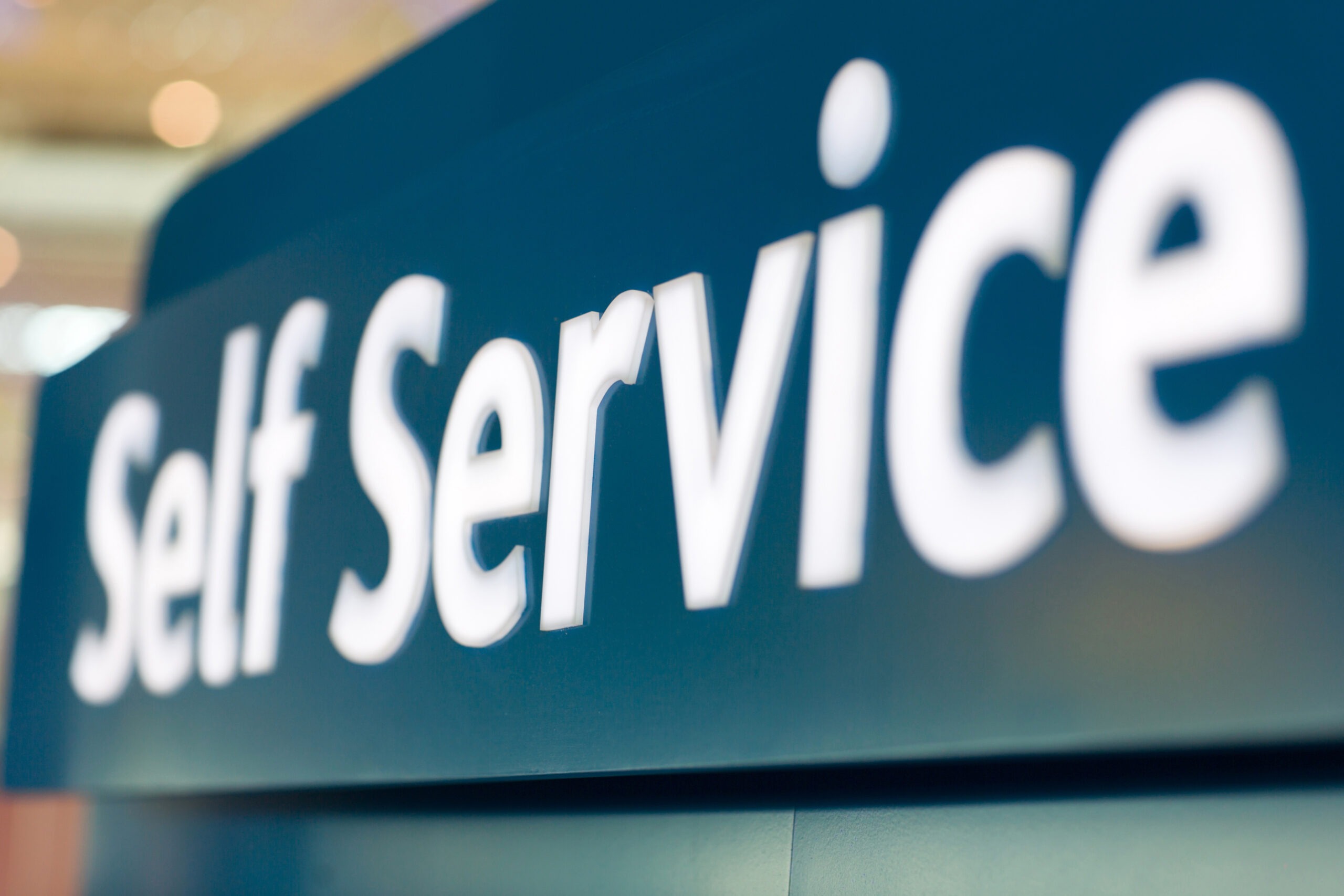 They also have boots-on-the-ground knowledge about the market and cultivated relationships that are AI-proof. Now more than ever, radio needs solid storytellers on the front lines preaching the power of radio advertising. But these pros can’t make their paychecks focusing on high-quantity, low-value orders that self-service platforms seamlessly bring in.
They also have boots-on-the-ground knowledge about the market and cultivated relationships that are AI-proof. Now more than ever, radio needs solid storytellers on the front lines preaching the power of radio advertising. But these pros can’t make their paychecks focusing on high-quantity, low-value orders that self-service platforms seamlessly bring in.
Where are the self-service advertising websites for small businesses to advertise radio — over-the-air or digitally? How does radio connect with the long-tail of smaller advertisers who can be upsold into larger packages as their businesses grow?
To be sure, a custom, fully self-service portal that integrates an AI-spot-creation tool with the stations’ automation system requires significant resources in capital, silicone, and technical grey matter.
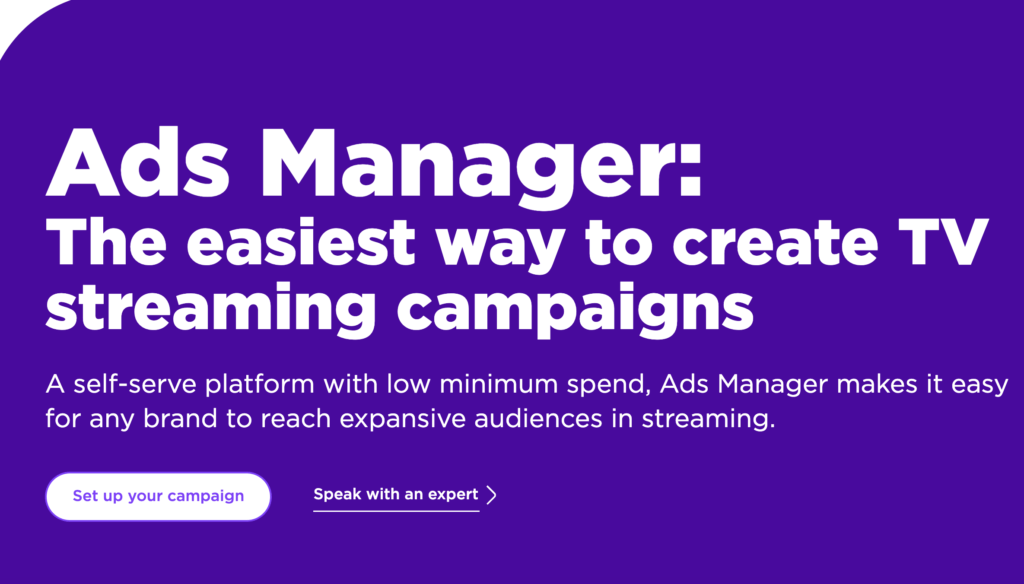 However, there are off-the-shelf tools that get a good chunk of the way there to make the ad-buying process more frictionless. CRM systems like Zoho and Hubspot can be set-up for clients to provide all the relevant information — including e-commerce options to process credit cards — so a sales assistant could call the client the next morning with their Eleven Labs or SpotOn produced spot for approval.
However, there are off-the-shelf tools that get a good chunk of the way there to make the ad-buying process more frictionless. CRM systems like Zoho and Hubspot can be set-up for clients to provide all the relevant information — including e-commerce options to process credit cards — so a sales assistant could call the client the next morning with their Eleven Labs or SpotOn produced spot for approval.
The radio industry has a proud history of resilience and adaptation. To secure the future of radio advertising, innovation and adaptation to the changing landscape of SMB advertising is a must. By developing self-service platforms that cater to the needs of small business owners, radio can continue to thrive and remain a dominant mass medium.
Embracing these technological advancements will not only streamline the ad-buying process but also ensure that radio stays relevant and competitive in the ever-evolving media industry.
Talk to Chris. His focus is on digital revenue generation and AI. You can reach him here. And subscribe to AI Edge, his weekly news letter on artificial intelligence custom written for radio broadcasters. You can sign up here.
- Evolution - May 9, 2025
- It’s Not the AI, It’s the Cover Up - May 2, 2025
- This Is the Worst AI You’ll Ever Use - April 11, 2025




In addition to being able to get underwriting on the air the same day at our public radio station, I take comfort in knowing that no online/AI service is going to drop off homemade chocolate chip cookies to any client ever.
100%. The relationships keep
the wins coming — and chocolate chip cookies make them sweeter 🙂
“Where is radio’s ‘EASY’ button for advertisers?”
Wow, what a great question. Will broadcasters respond to that question now? I hope so. As Chris points out, radio is still the most consumed of all media. Let’s not put obstacles in the way between advertisers and that audience. And at the same time, as both Chris and L. Loy above point out, let’s keep those chocolate chip cookies baking for the AEs to drop off.
That’s a great point! Removing obstacles is so important. Simplifying the process for advertisers while maintaining strong relationships with their audience is key.